TOYOTA PRIUS PRIME 2023 Owners Manual
Manufacturer: TOYOTA, Model Year: 2023, Model line: PRIUS PRIME, Model: TOYOTA PRIUS PRIME 2023Pages: 680, PDF Size: 14.97 MB
Page 331 of 680
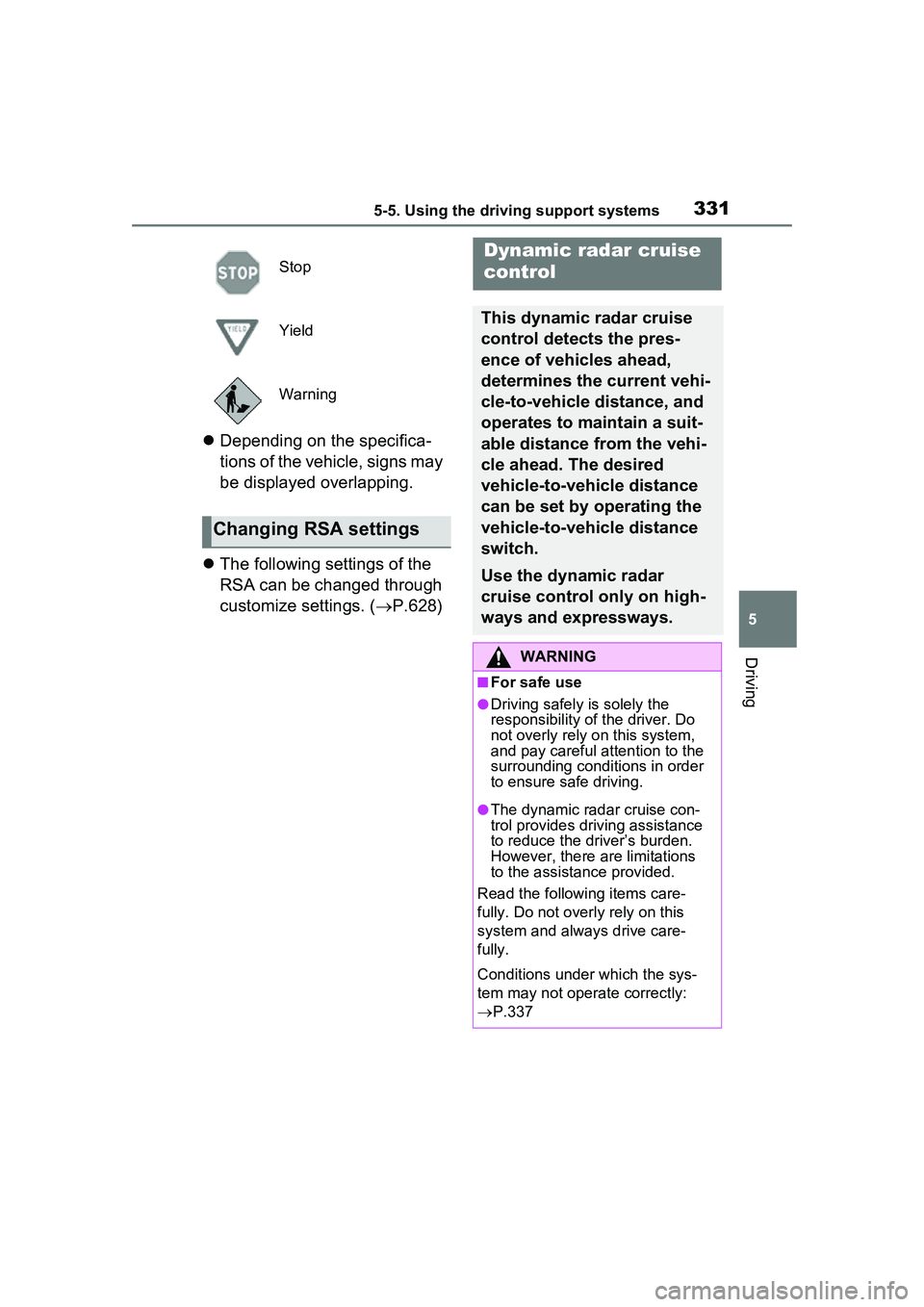
3315-5. Using the driving support systems
5
Driving
Depending on the specifica-
tions of the vehicle, signs may
be displayed overlapping.
The following settings of the
RSA can be changed through
customize settings. ( P.628)
Stop
Yield
Warning
Changing RSA settings
Dynamic radar cruise
control
This dynamic radar cruise
control detects the pres-
ence of vehicles ahead,
determines the current vehi-
cle-to-vehicle distance, and
operates to maintain a suit-
able distance from the vehi-
cle ahead. The desired
vehicle-to-vehicle distance
can be set by operating the
vehicle-to-vehicle distance
switch.
Use the dynamic radar
cruise control only on high-
ways and expressways.
WARNING
■For safe use
●Driving safely is solely the
responsibility of the driver. Do
not overly rely on this system,
and pay careful attention to the
surrounding conditions in order
to ensure safe driving.
●The dynamic radar cruise con-
trol provides driving assistance
to reduce the driver’s burden.
However, there are limitations
to the assistance provided.
Read the following items care-
fully. Do not overly rely on this
system and always drive care-
fully.
Conditions under which the sys-
tem may not operate correctly:
P.337
Page 332 of 680
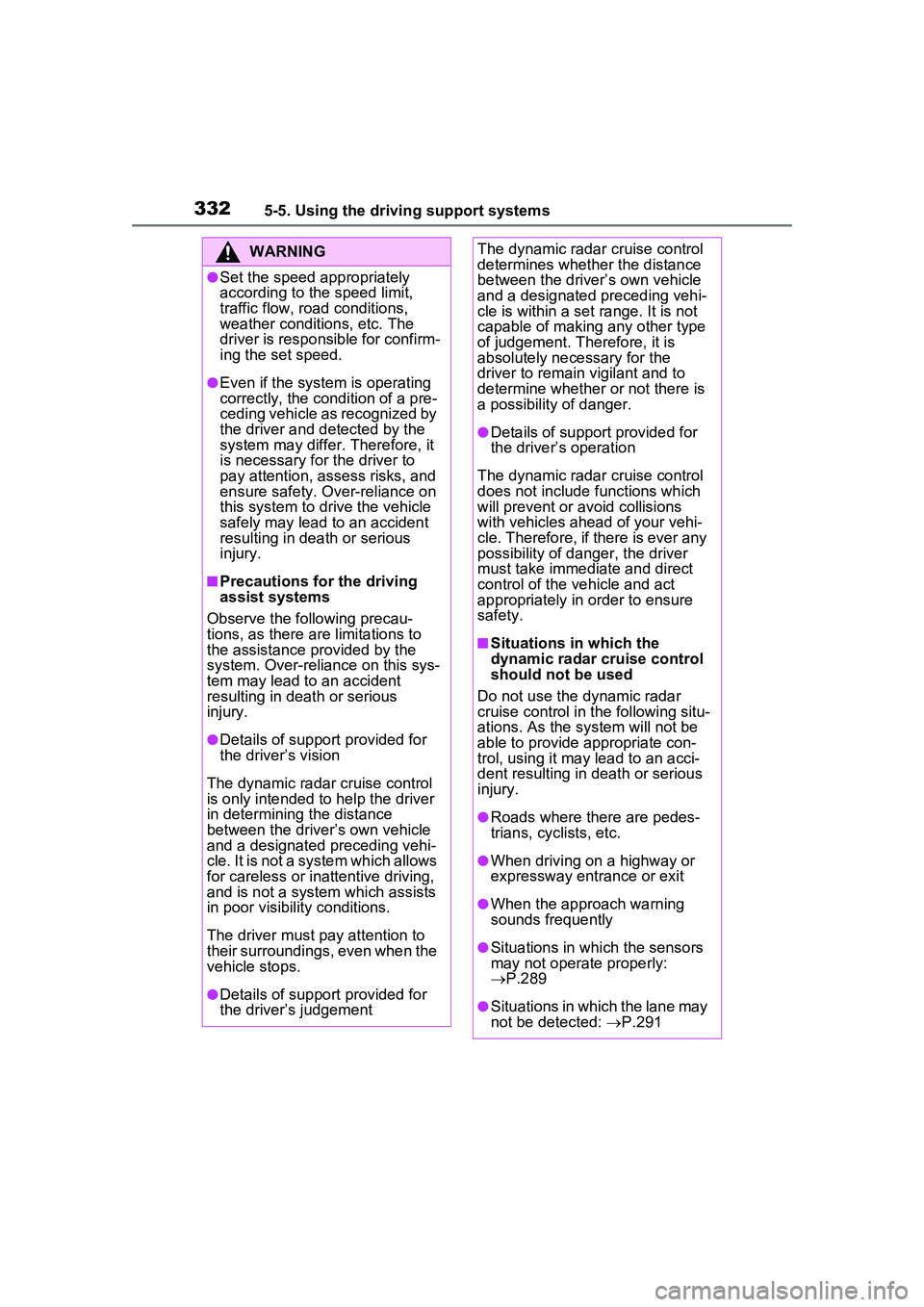
3325-5. Using the driving support systems
WARNING
●Set the speed appropriately
according to the speed limit,
traffic flow, road conditions,
weather conditions, etc. The
driver is responsible for confirm-
ing the set speed.
●Even if the system is operating
correctly, the condition of a pre-
ceding vehicle as recognized by
the driver and detected by the
system may differ. Therefore, it
is necessary for the driver to
pay attention, assess risks, and
ensure safety. Over-reliance on
this system to drive the vehicle
safely may lead to an accident
resulting in death or serious
injury.
■Precautions for the driving
assist systems
Observe the following precau-
tions, as there are limitations to
the assistance provided by the
system. Over-reliance on this sys-
tem may lead to an accident
resulting in death or serious
injury.
●Details of support provided for
the driver’s vision
The dynamic radar cruise control
is only intended to help the driver
in determining the distance
between the driver’s own vehicle
and a designated preceding vehi-
cle. It is not a system which allows
for careless or i nattentive driving,
and is not a system which assists
in poor visibility conditions.
The driver must pay attention to
their surroundings, even when the
vehicle stops.
●Details of support provided for
the driver’s judgement
The dynamic radar cruise control
determines whether the distance
between the driver’s own vehicle
and a designated preceding vehi-
cle is within a set range. It is not
capable of making any other type
of judgement. Therefore, it is
absolutely necessary for the
driver to remain vigilant and to
determine whether or not there is
a possibility of danger.
●Details of support provided for
the driver’s operation
The dynamic radar cruise control
does not include functions which
will prevent or avoid collisions
with vehicles ahead of your vehi-
cle. Therefore, if there is ever any
possibility of danger, the driver
must take immediate and direct
control of the vehicle and act
appropriately in order to ensure
safety.
■Situations in which the
dynamic radar cruise control
should not be used
Do not use the dynamic radar
cruise control in the following situ-
ations. As the system will not be
able to provide appropriate con-
trol, using it may lead to an acci-
dent resulting in death or serious
injury.
●Roads where there are pedes-
trians, cyclists, etc.
●When driving on a highway or
expressway entrance or exit
●When the approach warning
sounds frequently
●Situations in which the sensors
may not operate properly:
P.289
●Situations in which the lane may
not be detected: P.291
Page 333 of 680
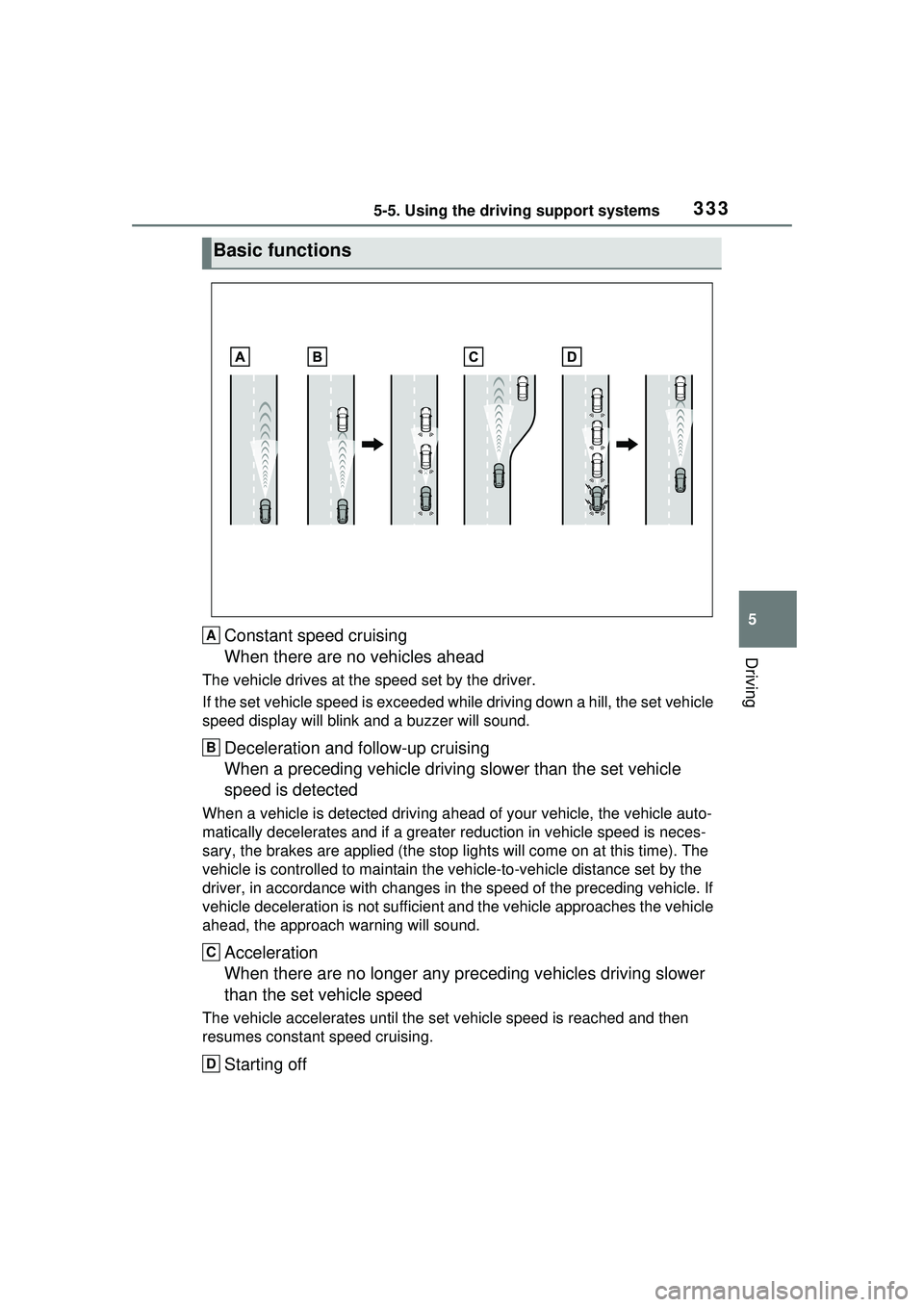
3335-5. Using the driving support systems
5
Driving
Constant speed cruising
When there are no vehicles ahead
The vehicle drives at the speed set by the driver.
If the set vehicle speed is exceeded while driving down a hill, the set vehicle
speed display will blink and a buzzer will sound.
Deceleration and follow-up cruising
When a preceding vehicle driving slower than the set vehicle
speed is detected
When a vehicle is detected driving ahead of your vehicle, the vehicle auto-
matically decelerates and if a greater reduction in vehicle speed is neces-
sary, the brakes are applied (the stop lights will come on at this time). The
vehicle is controlled to ma intain the vehicle-to-vehicle distance set by the
driver, in accordance with changes in the speed of the preceding vehicle. If
vehicle deceleration is not sufficient an d the vehicle approaches the vehicle
ahead, the ap proach warning will sound.
Acceleration
When there are no longer any pr eceding vehicles driving slower
than the set vehicle speed
The vehicle accelerates until the set vehicle speed is reached and then
resumes constant speed cruising.
Starting off
Basic functions
A
B
C
D
Page 334 of 680
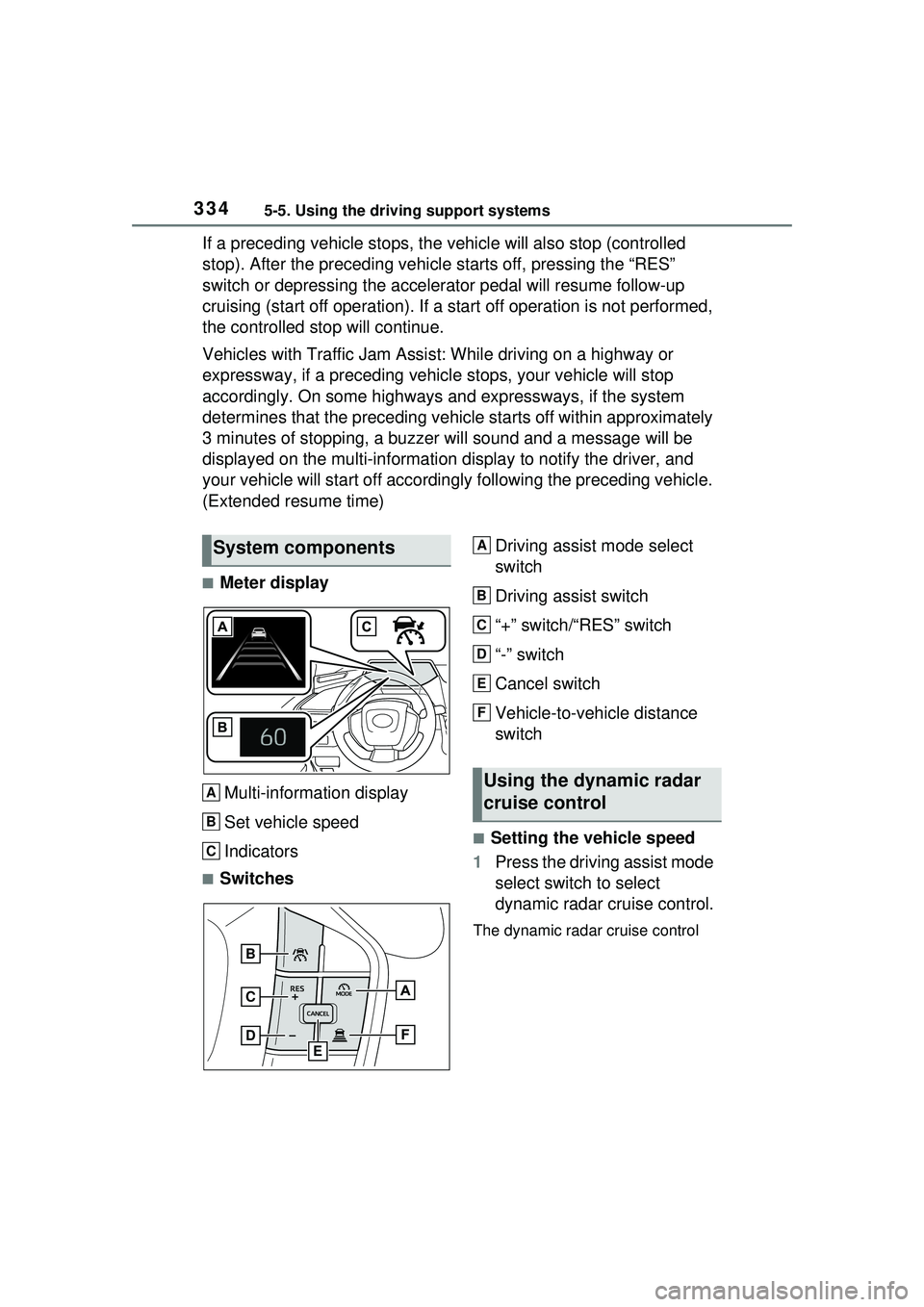
3345-5. Using the driving support systems
If a preceding vehicle stops, the vehicle will also stop (controlled
stop). After the preceding vehicle starts off, pressing the “RES”
switch or depressing the accelerator pedal will resume follow-up
cruising (start off operation). If a start off operation is not performed,
the controlled stop will continue.
Vehicles with Traffic Jam Assist : While driving on a highway or
expressway, if a preceding vehicl e stops, your vehicle will stop
accordingly. On some highways and expressways, if the system
determines that the preceding vehicle starts off within approximately
3 minutes of stopping, a buzzer will sound and a message will be
displayed on the multi-information display to notify the driver, and
your vehicle will start off accordingly following the preceding vehicle.
(Extended resume time)
■Meter display
Multi-information display
Set vehicle speed
Indicators
■Switches Driving assist mode select
switch
Driving assist switch
“+” switch/“RES” switch
“-” switch
Cancel switch
Vehicle-to-vehicle distance
switch
■Setting the vehicle speed
1 Press the driving assist mode
select switch to select
dynamic radar cruise control.
The dynamic radar cruise control
System components
A
B
C
B
C
FD
E
Using the dynamic radar
cruise control
A
B
C
D
E
F
Page 335 of 680
![TOYOTA PRIUS PRIME 2023 Owners Manual 3355-5. Using the driving support systems
5
Driving
indicator will illuminate.
2Using the accelerator pedal,
accelerate or decelerate to
the desired vehicle speed
(approximately 20 mph [30
km/h] o TOYOTA PRIUS PRIME 2023 Owners Manual 3355-5. Using the driving support systems
5
Driving
indicator will illuminate.
2Using the accelerator pedal,
accelerate or decelerate to
the desired vehicle speed
(approximately 20 mph [30
km/h] o](/img/14/68572/w960_68572-334.png)
3355-5. Using the driving support systems
5
Driving
indicator will illuminate.
2Using the accelerator pedal,
accelerate or decelerate to
the desired vehicle speed
(approximately 20 mph [30
km/h] or more), and press the
driving assist switch to set
the set vehicle speed.
The set vehicle speed will be dis-
played on the multi-information dis-
play.
The vehicle speed at the moment
the switch is released will be the set
vehicle speed.
■Adjusting the set vehicle
speed
Adjusting the set vehicle
speed using the switches
To change the set vehicle
speed, press the “+” switch or “-”
switch until the desired speed is
displayed. 1
Increase set vehicle speed
2 Decrease set vehicle speed
Short press adjustment: Press the
switch
Long press adjustment: Press and
hold the switch until the desired set
vehicle speed is reached.
The set vehicle speed will
increase or decrease as follows:
For the U.S. mainland, Hawaii
and Puerto Rico
Short press adjustment:
Increases or decreases by 1
mph (1.6 km/h) each time the
switch is pressed
Long press adjustment:
Increases or decreases in 1
mph (1.6 km/h) increments con-
tinuously while the switch is
pressed and held
Except for the U.S. mainland,
Hawaii and Puerto Rico
Short press adjustment: By 0.6
mph (1 km/h) or 1.6 km/h (1
mph) each time the switch is
pressed
Long press adjustment:
Increases or decreases in 3.1
mph (5 km/h) or 8 km/h (5 mph)
Page 336 of 680
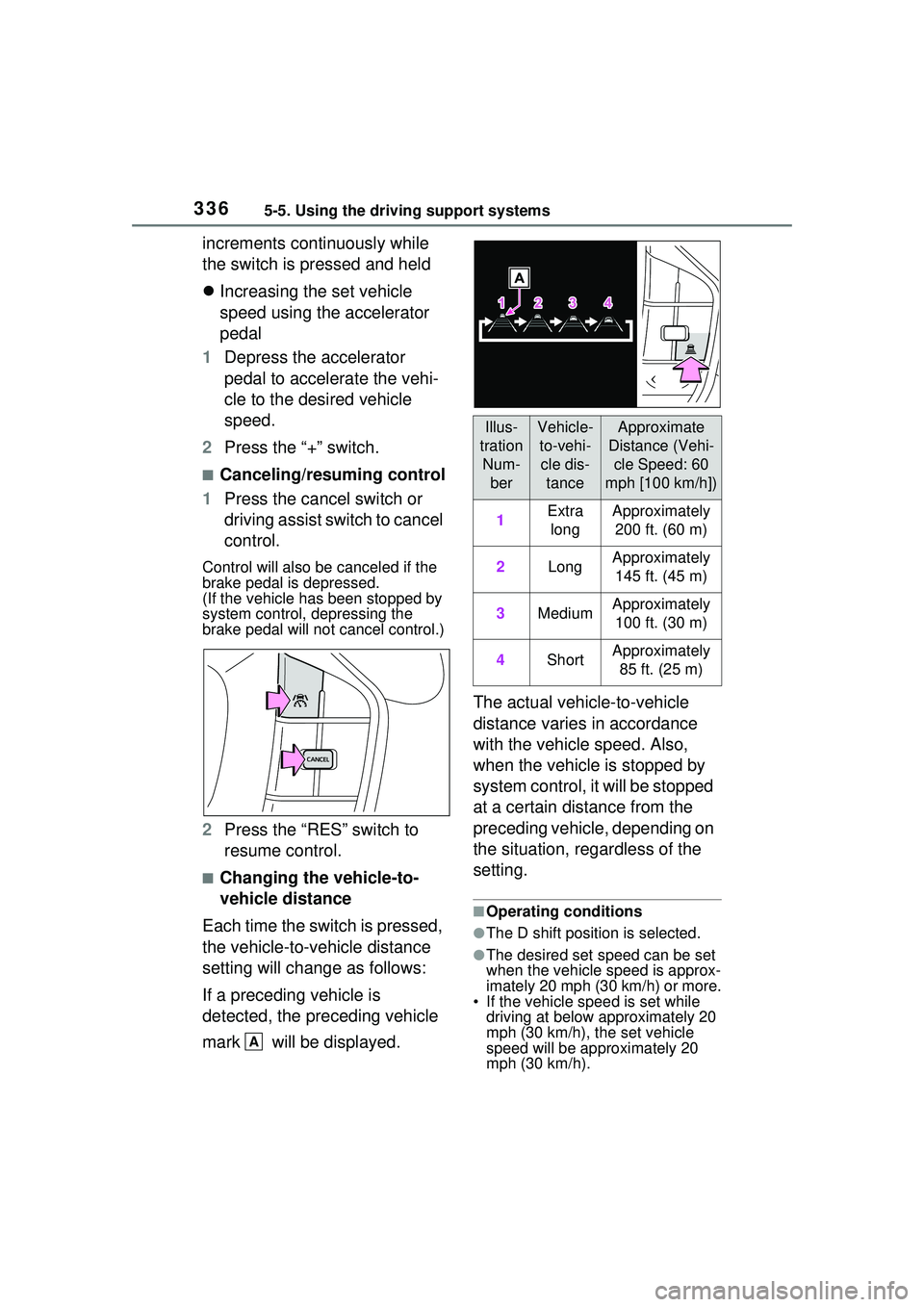
3365-5. Using the driving support systems
increments continuously while
the switch is pressed and held
Increasing the set vehicle
speed using the accelerator
pedal
1 Depress the accelerator
pedal to accelerate the vehi-
cle to the desired vehicle
speed.
2 Press the “+” switch.
■Canceling/resuming control
1 Press the cancel switch or
driving assist switch to cancel
control.
Control will also be canceled if the
brake pedal is depressed.
(If the vehicle has been stopped by
system control, depressing the
brake pedal will not cancel control.)
2 Press the “RES” switch to
resume control.
■Changing the vehicle-to-
vehicle distance
Each time the switch is pressed,
the vehicle-to-vehicle distance
setting will change as follows:
If a preceding vehicle is
detected, the preceding vehicle
mark will be displayed. The actual vehicle-to-vehicle
distance varies in accordance
with the vehicle speed. Also,
when the vehicle is stopped by
system control, it will be stopped
at a certain distance from the
preceding vehicle, depending on
the situation, regardless of the
setting.
■Operating conditions
●The D shift position is selected.
●The desired set speed can be set
when the vehicle speed is approx-
imately 20 mph (30 km/h) or more.
• If the vehicle speed is set while driving at below approximately 20
mph (30 km/h), the set vehicle
speed will be approximately 20
mph (30 km/h).
A
Illus-
tration Num- berVehicle-to-vehi-cle dis- tanceApproximate
Distance (Vehi- cle Speed: 60
mph [100 km/h])
1Extra longApproximately 200 ft. (60 m)
2LongApproximately 145 ft. (45 m)
3MediumApproximately 100 ft. (30 m)
4ShortApproximately 85 ft. (25 m)
Page 337 of 680
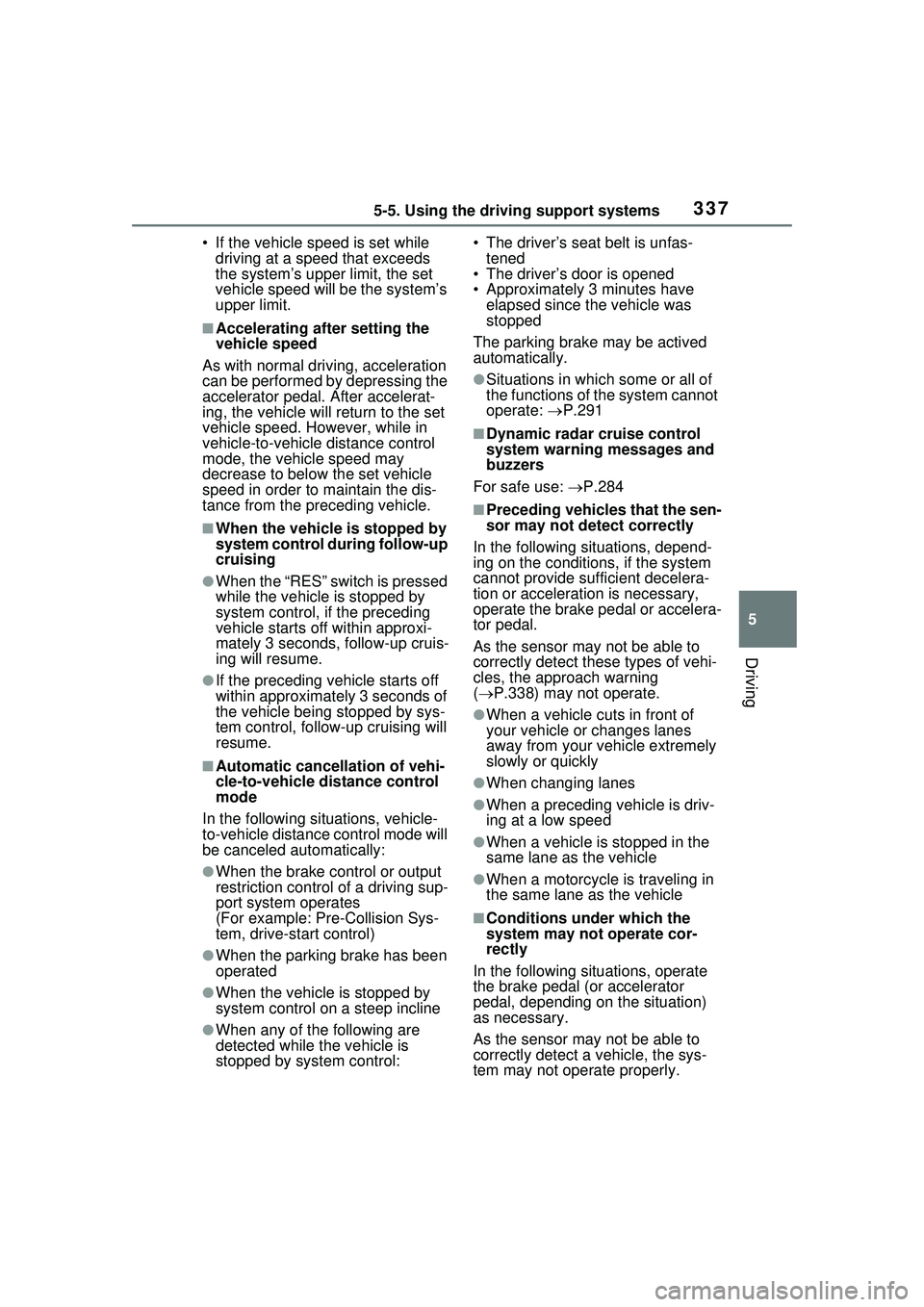
3375-5. Using the driving support systems
5
Driving
• If the vehicle speed is set while driving at a speed that exceeds
the system’s upper limit, the set
vehicle speed will be the system’s
upper limit.
■Accelerating after setting the
vehicle speed
As with normal driving, acceleration
can be performed by depressing the
accelerator pedal. After accelerat-
ing, the vehicle will return to the set
vehicle speed. However, while in
vehicle-to-vehicle distance control
mode, the vehicle speed may
decrease to below the set vehicle
speed in order to maintain the dis-
tance from the preceding vehicle.
■When the vehicle is stopped by
system control during follow-up
cruising
●When the “RES” switch is pressed
while the vehicle is stopped by
system control, if the preceding
vehicle starts off within approxi-
mately 3 seconds, follow-up cruis-
ing will resume.
●If the preceding vehicle starts off
within approximately 3 seconds of
the vehicle being stopped by sys-
tem control, follo w-up cruising will
resume.
■Automatic cancellation of vehi-
cle-to-vehicle distance control
mode
In the following situations, vehicle-
to-vehicle distance control mode will
be canceled automatically:
●When the brake control or output
restriction control of a driving sup-
port system operates
(For example: Pre-Collision Sys-
tem, drive-start control)
●When the parking brake has been
operated
●When the vehicle is stopped by
system control on a steep incline
●When any of the following are
detected while the vehicle is
stopped by system control: • The driver’s seat belt is unfas-
tened
• The driver’s door is opened
• Approximately 3 minutes have
elapsed since the vehicle was
stopped
The parking brake may be actived
automatically.
●Situations in which some or all of
the functions of the system cannot
operate: P.291
■Dynamic radar cruise control
system warning messages and
buzzers
For safe use: P.284
■Preceding vehicles that the sen-
sor may not detect correctly
In the following situations, depend-
ing on the conditions, if the system
cannot provide sufficient decelera-
tion or acceleration is necessary,
operate the brake pedal or accelera-
tor pedal.
As the sensor may not be able to
correctly detect these types of vehi-
cles, the approach warning
( P.338) may not operate.
●When a vehicle cuts in front of
your vehicle or changes lanes
away from your vehicle extremely
slowly or quickly
●When changing lanes
●When a preceding vehicle is driv-
ing at a low speed
●When a vehicle is stopped in the
same lane as the vehicle
●When a motorcycle is traveling in
the same lane as the vehicle
■Conditions under which the
system may not operate cor-
rectly
In the following situations, operate
the brake pedal (or accelerator
pedal, depending on the situation)
as necessary.
As the sensor may not be able to
correctly detect a vehicle, the sys-
tem may not operate properly.
Page 338 of 680
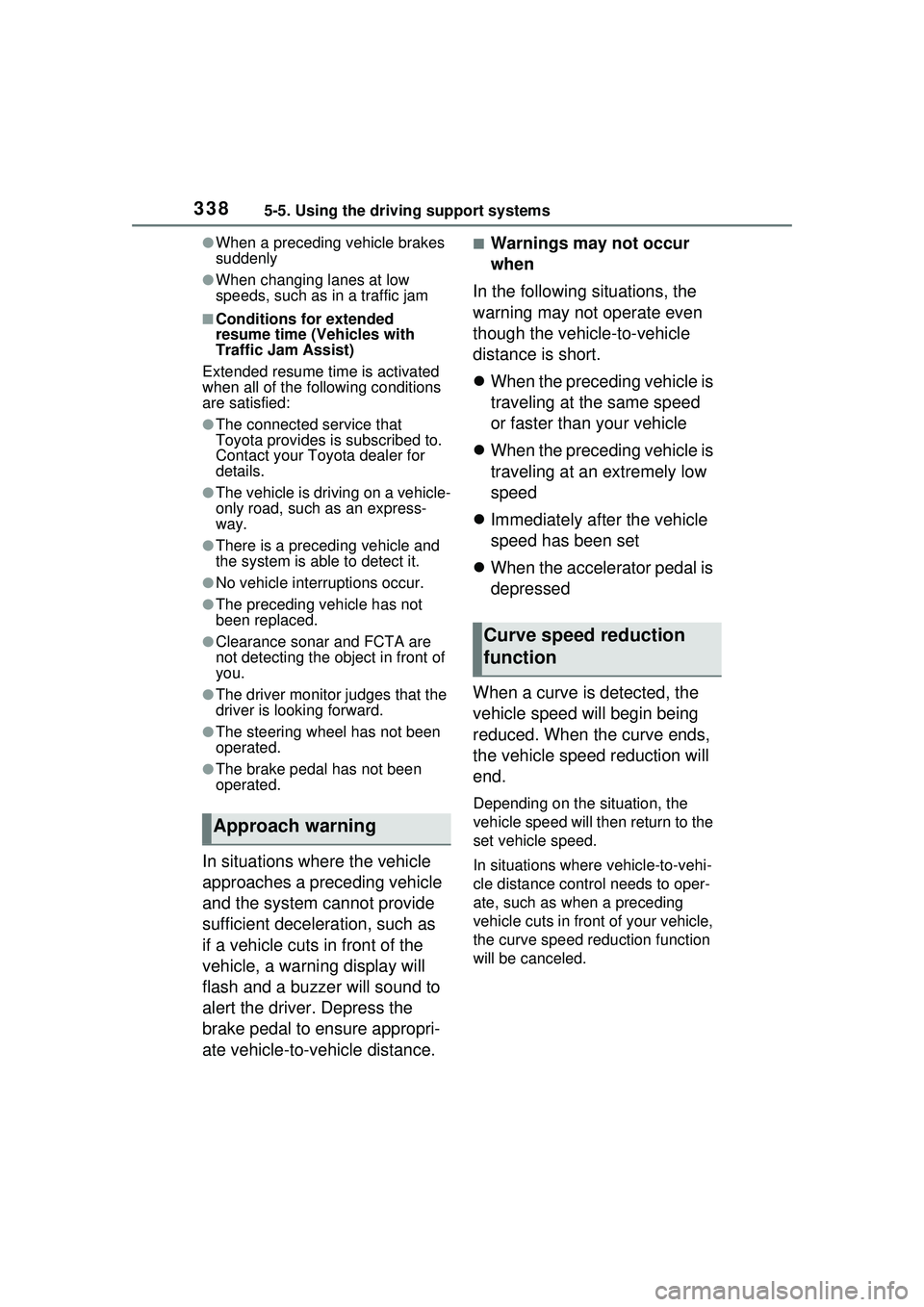
3385-5. Using the driving support systems
●When a preceding vehicle brakes
suddenly
●When changing lanes at low
speeds, such as in a traffic jam
■Conditions for extended
resume time (Vehicles with
Traffic Jam Assist)
Extended resume ti me is activated
when all of the following conditions
are satisfied:
●The connected service that
Toyota provides is subscribed to.
Contact your Toyota dealer for
details.
●The vehicle is driving on a vehicle-
only road, such as an express-
way.
●There is a preceding vehicle and
the system is able to detect it.
●No vehicle interruptions occur.
●The preceding vehicle has not
been replaced.
●Clearance sonar and FCTA are
not detecting the object in front of
you.
●The driver monitor judges that the
driver is looking forward.
●The steering wheel has not been
operated.
●The brake pedal has not been
operated.
In situations where the vehicle
approaches a preceding vehicle
and the system cannot provide
sufficient deceleration, such as
if a vehicle cuts in front of the
vehicle, a warning display will
flash and a buzzer will sound to
alert the driver. Depress the
brake pedal to ensure appropri-
ate vehicle-to-vehicle distance.
■Warnings may not occur
when
In the following situations, the
warning may not operate even
though the vehicle-to-vehicle
distance is short.
When the preceding vehicle is
traveling at the same speed
or faster than your vehicle
When the preceding vehicle is
traveling at an extremely low
speed
Immediately after the vehicle
speed has been set
When the accelerator pedal is
depressed
When a curve is detected, the
vehicle speed will begin being
reduced. When the curve ends,
the vehicle speed reduction will
end.
Depending on the situation, the
vehicle speed will then return to the
set vehicle speed.
In situations where vehicle-to-vehi-
cle distance control needs to oper-
ate, such as when a preceding
vehicle cuts in front of your vehicle,
the curve speed reduction function
will be canceled.
Approach warning
Curve speed reduction
function
Page 339 of 680
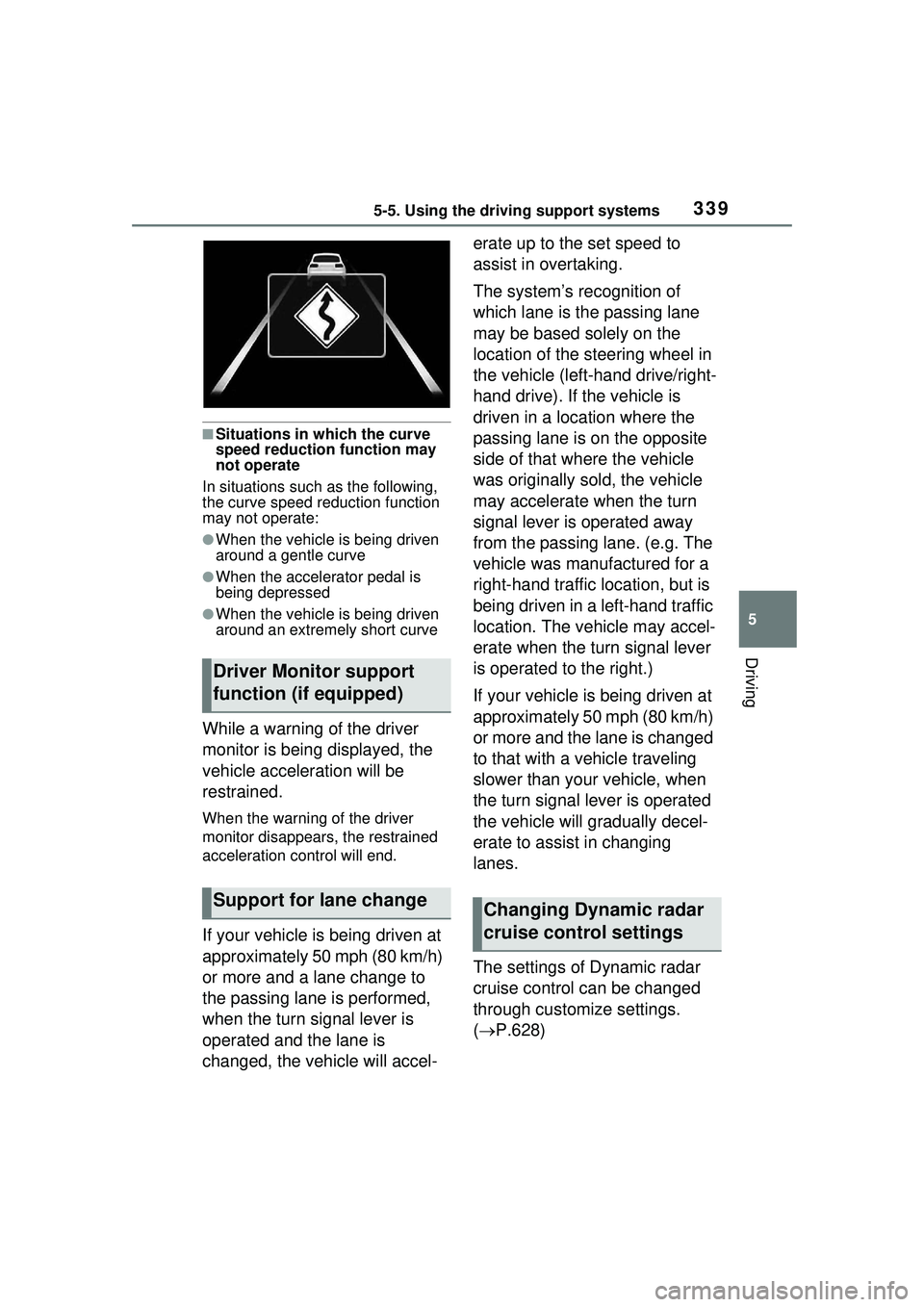
3395-5. Using the driving support systems
5
Driving
■Situations in which the curve
speed reduction function may
not operate
In situations such as the following,
the curve speed reduction function
may not operate:
●When the vehicle is being driven
around a gentle curve
●When the accelerator pedal is
being depressed
●When the vehicle is being driven
around an extremely short curve
While a warning of the driver
monitor is being displayed, the
vehicle acceleration will be
restrained.
When the warning of the driver
monitor disappears, the restrained
acceleration control will end.
If your vehicle is being driven at
approximately 50 mph (80 km/h)
or more and a lane change to
the passing lane is performed,
when the turn signal lever is
operated and the lane is
changed, the vehicle will accel- erate up to the set speed to
assist in overtaking.
The system’s recognition of
which lane is the passing lane
may be based solely on the
location of the steering wheel in
the vehicle (left-hand drive/right-
hand drive). If the vehicle is
driven in a location where the
passing lane is on the opposite
side of that where the vehicle
was originally sold, the vehicle
may accelerate when the turn
signal lever is operated away
from the passing lane. (e.g. The
vehicle was manufactured for a
right-hand traffic location, but is
being driven in a left-hand traffic
location. The vehicle may accel-
erate when the turn signal lever
is operated to the right.)
If your vehicle is being driven at
approximately 50 mph (80 km/h)
or more and the lane is changed
to that with a vehicle traveling
slower than your vehicle, when
the turn signal lever is operated
the vehicle will
gradually decel-
erate to assist in changing
lanes.
The settings of Dynamic radar
cruise control can be changed
through customize settings.
( P.628)
Driver Monitor support
function (if equipped)
Support for lane changeChanging Dynamic radar
cruise control settings
Page 340 of 680
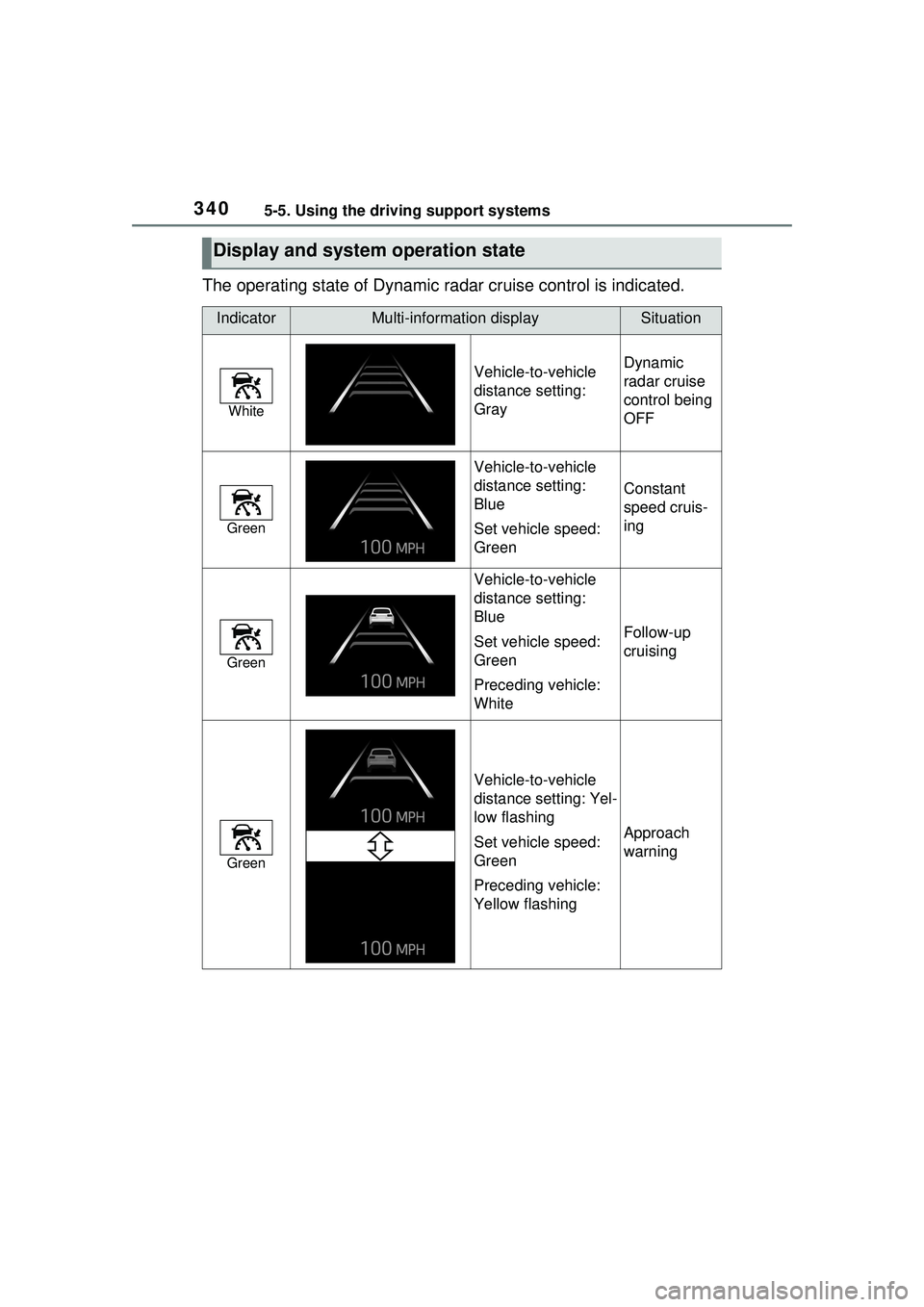
3405-5. Using the driving support systems
The operating state of Dynamic radar cruise control is indicated.
Display and system operation state
IndicatorMulti-information displaySituation
White
Vehicle-to-vehicle
distance setting:
GrayDynamic
radar cruise
control being
OFF
Green
Vehicle-to-vehicle
distance setting:
Blue
Set vehicle speed:
Green
Constant
speed cruis-
ing
Green
Vehicle-to-vehicle
distance setting:
Blue
Set vehicle speed:
Green
Preceding vehicle:
White
Follow-up
cruising
Green
Vehicle-to-vehicle
distance setting: Yel-
low flashing
Set vehicle speed:
Green
Preceding vehicle:
Yellow flashing
Approach
warning